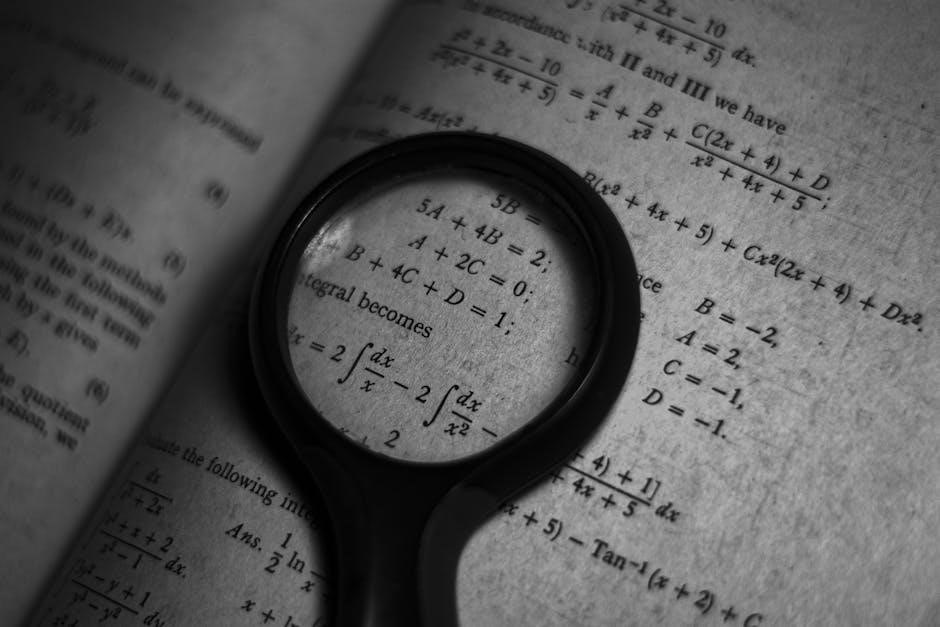Carnegie Learning Answer Key PDF provides detailed solutions for math problems, supporting Algebra 1, Algebra 2, and Middle School Math courses. It aids students and educators in understanding complex concepts through step-by-step explanations, aligning with curriculum standards and fostering academic success.
1.1 Overview of Carnegie Learning Resources
Carnegie Learning resources, including the Answer Key PDF, are designed to support students and educators in math education. These resources cover a wide range of topics, from foundational concepts in middle school math to advanced algebraic thinking. They include detailed answer keys, step-by-step solutions, and practice problems aligned with curriculum standards. The materials are structured to enhance understanding and retention, offering real-time insights and assessments. Additionally, Carnegie Learning provides supplementary tools like eBooks, audio/video files, and performance assessments. These resources are tailored to meet the needs of diverse learners, ensuring comprehensive support for academic success. By integrating these materials, students can build a strong foundation in mathematics and develop problem-solving skills with confidence.
1.2 Importance of Answer Keys in Learning
Answer keys play a vital role in the learning process by providing students with clear and accurate solutions to practice problems. They help verify the correctness of answers, reducing confusion and reinforcing understanding. Detailed explanations in Carnegie Learning Answer Key PDFs enable students to identify mistakes and learn from them, fostering improved problem-solving skills. These resources also promote independent study by offering step-by-step guidance, which enhances retention and confidence. Additionally, answer keys aligned with curriculum standards ensure that students are well-prepared for assessments. By catering to diverse learning needs, Carnegie Learning resources empower students to master mathematical concepts effectively, making them indispensable tools for academic success.

Algebra 1 Answer Key
Algebra 1 Answer Key provides detailed solutions for practice problems, covering linear functions, systems of equations, and exponential functions, supporting students with clear, step-by-step explanations.
2.1 Linear Functions and Equations
Carnegie Learning’s resources emphasize understanding linear functions and equations, offering solutions to problems like graphing lines and solving equations. The answer key provides clear explanations for determining if equations have one solution, no solution, or infinite solutions, enhancing problem-solving skills.
2.2 Systems of Equations and Inequalities
The Carnegie Learning Answer Key PDF offers comprehensive solutions for systems of equations and inequalities, guiding students through graphing, substitution, and elimination methods. It provides detailed explanations for solving systems, including identifying dependent and independent solutions. Inequalities are addressed with step-by-step processes, ensuring clarity in graphing solutions on number lines. Real-world applications are highlighted, making abstract concepts more relatable. These resources align with curriculum standards, helping students master essential algebraic skills and prepare for advanced problem-solving.
Algebra 2 Answer Key
Carnegie Learning’s Algebra 2 Answer Key offers detailed solutions for exponential and logarithmic functions, advanced algebra topics, and practice problems. It supports student understanding and mastery.
3.1 Exponential and Logarithmic Functions
The Carnegie Learning Answer Key PDF provides comprehensive solutions for exponential and logarithmic functions, covering topics like graphing, solving equations, and understanding properties. It offers step-by-step explanations for complex problems, helping students grasp these essential algebraic concepts. The resource aligns with curriculum standards, ensuring relevance and depth. By breaking down intricate functions into manageable parts, the answer key fosters a deeper understanding of exponential growth, decay, and logarithmic relationships. Additionally, it includes practical applications, enabling students to connect abstract math to real-world scenarios. This section is invaluable for students seeking clarity and mastery in these critical areas of Algebra 2.
3.2 Advanced Topics in Algebra
The Carnegie Learning Answer Key PDF delves into advanced algebraic concepts, such as polynomials, rational expressions, and conic sections. It provides detailed solutions for complex problems, ensuring students can follow along and understand the reasoning behind each step. Topics like solving higher-degree equations, working with inverse functions, and analyzing sequences and series are also covered. The answer key emphasizes critical thinking and problem-solving strategies, helping students tackle challenging algebraic scenarios. By aligning with curriculum standards, it ensures comprehensive coverage of advanced topics. This resource is invaluable for students aiming to master higher-level algebra, offering clarity and precision in its explanations. It bridges the gap between theory and application, making abstract concepts more accessible and practical.

Middle School Math Solution Answer Key
The Carnegie Learning Answer Key supports middle school math courses, offering detailed solutions for foundational concepts, proportional reasoning, and algebraic thinking, aligned with curriculum standards.
4.1 Course 1: Foundational Concepts
Course 1 of Carnegie Learning’s Middle School Math Solution focuses on foundational concepts, building a strong base in ratios, proportions, and basic algebraic expressions. The answer key provides detailed solutions for practice problems, ensuring students grasp essential math skills. It covers topics like number sense, operations, and introductory algebra, with step-by-step explanations. Visual aids and real-world examples are included to enhance understanding. The resource aligns with curriculum standards, making it a reliable tool for both students and educators. By mastering these foundational concepts, students are better prepared for advanced math topics in subsequent courses. The answer key also supports differentiated instruction, catering to diverse learning needs and fostering a deeper appreciation for mathematics.

4.2 Course 2: Proportional Reasoning
Course 2 emphasizes proportional reasoning, crucial for developing advanced math skills. The answer key offers detailed solutions for problems involving ratios, percentages, and proportional relationships. It helps students understand how to apply these concepts to real-world scenarios, fostering critical thinking. Practice exercises focus on identifying proportional relationships, solving proportion problems, and interpreting graphs. The resource includes step-by-step guidance, ensuring clarity and reinforcing learning. By mastering proportional reasoning, students build a solid foundation for algebra and higher-level mathematics. The answer key aligns with curriculum standards, providing educators with a reliable tool to assess student progress and understanding.
4.3 Course 3: Algebraic Thinking
Course 3 focuses on algebraic thinking, helping students develop skills in solving equations, working with variables, and understanding functions. The answer key provides detailed solutions to practice problems, ensuring students grasp key concepts. It covers topics like linear equations, graphing, and algebraic expressions. The resource emphasizes problem-solving strategies, allowing students to approach challenges methodically. Step-by-step explanations clarify complex ideas, making them accessible. By mastering algebraic thinking, students prepare for advanced math courses. The answer key aligns with curriculum standards, offering educators a reliable tool for assessment and instruction. It fosters a deeper understanding of algebraic principles, essential for long-term academic success in mathematics.
Key Features of Carnegie Learning Answer Keys
Carnegie Learning Answer Keys offer detailed solutions, alignment with curriculum standards, and additional resources like eBooks and assessments, ensuring comprehensive support for students and educators.
5.1 Detailed Solutions for Practice Problems
Carnegie Learning Answer Keys provide comprehensive, step-by-step solutions to practice problems, enabling students to understand and solve complex math concepts effectively. These detailed explanations cover various topics, such as linear functions, systems of equations, and proportional reasoning. By breaking down each problem, learners can identify mistakes, grasp underlying principles, and build confidence in their problem-solving skills. The solutions are structured to align with curriculum standards, ensuring relevance and accuracy. This feature is particularly beneficial for self-study, as it offers clear guidance and reinforces learning objectives. Additionally, the answer keys cater to different learning styles, making them a valuable resource for both students and educators seeking to enhance understanding and academic performance.

5.2 Alignment with Curriculum Standards
Carnegie Learning Answer Keys are meticulously aligned with curriculum standards, ensuring that they meet the educational goals set for students. Each resource is designed to correspond with specific course objectives, covering topics like linear functions, proportional reasoning, and algebraic thinking. This alignment guarantees that the answer keys support both teaching and learning processes effectively. By adhering to established standards, Carnegie Learning resources help educators deliver consistent and high-quality instruction. Students benefit from materials that are relevant to their coursework, preparing them for assessments and future academic challenges. This curriculum alignment is a cornerstone of Carnegie Learning’s commitment to fostering student success and maintaining educational excellence across all grade levels.

How to Use Carnegie Learning Answer Keys Effectively
Use Carnegie Learning Answer Keys to verify solutions, identify mistakes, and reinforce understanding. They guide independent study and classroom instruction, ensuring mastery of math concepts effectively.
6.1 Step-by-Step Problem Solving
Carnegie Learning Answer Keys offer detailed, step-by-step solutions to practice problems, enabling students to follow logical reasoning and understand each concept thoroughly. By breaking down complex math problems into manageable parts, these keys help identify errors and improve problem-solving skills. They align with curriculum standards, ensuring relevance and accuracy. Students can use these keys to verify their work, gain confidence, and master algebraic thinking. The structured approach promotes independent learning and reinforces classroom instruction, making it an invaluable tool for academic success. Additionally, the keys support proportional reasoning, geometry, and statistical thinking, catering to diverse learning needs and fostering a deeper understanding of mathematics.
6.2 Enhancing Study Habits
Carnegie Learning Answer Keys play a crucial role in enhancing study habits by providing students with a structured approach to learning. The detailed solutions enable learners to track their progress, identify weaknesses, and focus on areas needing improvement; By aligning with curriculum standards, these resources ensure that students are well-prepared for assessments. The answer keys encourage independent learning, allowing students to practice problems at their own pace and review concepts as needed. They also promote critical thinking and time management skills, essential for academic success. Regular use of these keys fosters a consistent study routine, helping students develop a deeper understanding of mathematical concepts and improve their overall performance. This tool is particularly beneficial for reinforcing lessons and building confidence in problem-solving abilities.



































































